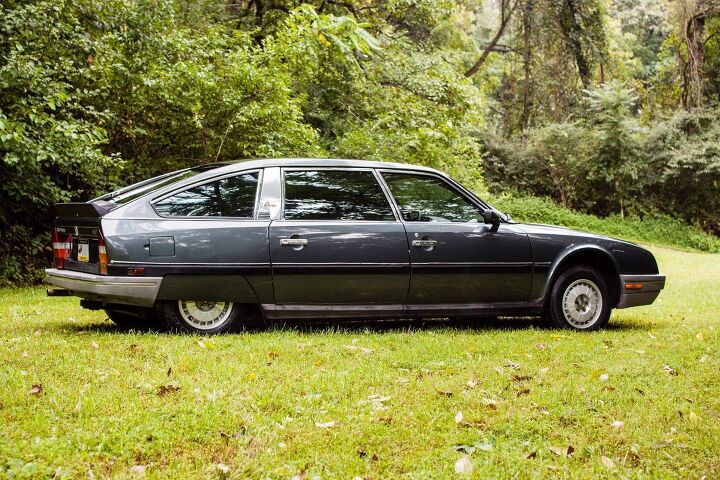Rare Rides: A Large, Luxurious Citron CX From 1987 (Part I)

Huge amounts of interior space, a silky smooth ride, and quirky features inside and out. These are the qualities one expects from a large Citroën, and all are present and accounted for in today’s Rare Ride — the CX 25 Prestige, from 1987.
We’ve featured a couple of Citroëns before in this series, appropriately starting with the groundbreaking Traction Avant from 1955, followed by the modern and angular 1994 XM liftback. Let’s backtrack a bit today, and talk more about Citroën flagships.
The CX was designated as the executive flagship offering from Citroën after the 20-year reign of the DS (which we’ll feature eventually here) came to an end. By this time, the DS’s 1955 design was overdue for replacement, and the CX shared space at dealers with its DS grandfather for model year 1975.
Citroën wanted to maintain the same basic shape of the DS in its new model, so that’s what they did. Immediately recognizable as a Citroën, the CX wore the same fastback proportions as its predecessor and boasted the same small trunk design — even though its appearance suggested a large liftback aperture.
Power was provided by inline-four engines of gasoline or diesel guise, ranging in displacement from 2.0 to 2.5 liters. Transmissions varied as well, with between three and five speeds, in manual, automatic, or semi-automatic form. Power figures were minimal, staying between 102 and 112 horsepower in all cases except the very rare, limited-production GTi Turbo, which produced 168 horses.
The new model proved an immediate success with the loyal DS buyer. Featuring many of the technological advancements found in the sleek SM (which we’ll also feature eventually), Citroën’s CX was rushed to market, and initial builds had some quality issues. Fixing these problems was a slow process, which is one of the many tales of woe in the saga of CX.
In Part II of Rare Rides Citroën CX Edition, we’ll cover the other issues with the company and the car. We’ll also find out how the CX seen here immigrated to the United States legally in 1987.
[Image: seller]

Interested in lots of cars and their various historical contexts. Started writing articles for TTAC in late 2016, when my first posts were QOTDs. From there I started a few new series like Rare Rides, Buy/Drive/Burn, Abandoned History, and most recently Rare Rides Icons. Operating from a home base in Cincinnati, Ohio, a relative auto journalist dead zone. Many of my articles are prompted by something I'll see on social media that sparks my interest and causes me to research. Finding articles and information from the early days of the internet and beyond that covers the little details lost to time: trim packages, color and wheel choices, interior fabrics. Beyond those, I'm fascinated by automotive industry experiments, both failures and successes. Lately I've taken an interest in AI, and generating "what if" type images for car models long dead. Reincarnating a modern Toyota Paseo, Lincoln Mark IX, or Isuzu Trooper through a text prompt is fun. Fun to post them on Twitter too, and watch people overreact. To that end, the social media I use most is Twitter, @CoreyLewis86. I also contribute pieces for Forbes Wheels and Forbes Home.
More by Corey Lewis
Latest Car Reviews
Read moreLatest Product Reviews
Read moreRecent Comments
- CanadaCraig As an aside... you are so incredibly vulnerable as you're sitting there WAITING for you EV to charge. It freaks me out.
- Wjtinfwb My local Ford dealer would be better served if the entire facility was AI. At least AI won't be openly hostile and confrontational to your basic requests when making or servicing you 50k plus investment and maybe would return a phone call or two.
- Ras815 Tesla is going to make for one of those fantastic corporate case studies someday. They had it all, and all it took was an increasingly erratic CEO empowered to make a few terrible, unchallenged ideas to wreck it.
- Dave Holzman Golden2husky remember you from well over decade ago in these comments. If I wanted to have a screen name that reflected my canine companionship, I'd be BorderCollie as of about five years go. Life is definitely better with dogs.
- Dave Holzman You're right about that!




































Comments
Join the conversation
I have a friend in the UK who owned one of these and absolutely loved everything about it except one small little detail - the engine electrics would just suddenly shut down leaving him completely stranded. Citroen replaced every piece of electrical kit in that car and it still didn't fix it. He was actually quite sad the day he got rid it - he thought it was the most brilliantly engineered car ever.
I have two comments: 1) So _that's_ where GM got inspiration for the bubble butt last-gen wagons! 2) Is that car stanced? It looks like the unholy love child of a Fuego and an Integra.